- Joined
- Jun 17, 2021
- Messages
- 1,642
- Points
- 488

This model was a prized item in the possession of an avid collector living in Annapolis about ten years ago. The model was deteriorating at an alarming rate and much in need of rescuing: stabilizing; cleaning; conservation and restoration of irreparably decaying parts, e.g. all the sails and rigging.
I carefully removed each sail and stored them in clear zip lock bags, backed by a square, larger than the sail, of Bristol board and labeled. These sails were so desiccated by UV as to be virtually no more stable to handle than ash. All the rigging was in the same shape and had to be replaced. I saved all the original hand made blocks and deadeyes to reuse later.
I used photos of the model and MS plans as well as The Anatomy of the Ship Constitution book as a guide to put it back together. I removed all the parts that needed to be repaired and that were coming loose, such as the guns and ships boats. The sails I reproduced by carefully tracing the outline of each onto Bristol board and penciled in all the seamlines. I glued muslin fabric flat and securely to each Bristol board Pattern with Elmer's glue stick which is reversable with water. I put a weighted flat board over each to keep them flat and for good, wrinkle free adhesion. Once dry, I traced all the seam lines onto the fabric with a #3 pencil. I glued wire along all the edges of the sails as "bolt ropes" which could be used to shape the sails later to give the appearance of being filled with wind. I tacked the wire "bolt ropes" in place with dots of CA gel (VERY sparingly as there is a serious antipathy between CA and fabric). to finish securing the wire I ran a discreet bead of white glue along the inside of the wire where it met the fabric and let it dry over night. once thoroughly dry, I very carefully cut away all the scrap board pattern right along the edges of the sail with a pair of scissors right up next to the wire "bolt ropes" I released the sails from the card stock backing pattern daubing them with a damp rag and working a long thin, flexible palette knife between the fabric and the backing until they separated. I had to touch up the gluing of the "bolt ropes" here and there but fortunately,
"it's better to b e lucky than good" About halfway through the project my customer asked if I could rig the guns, which they had not originally been. I said yes and added not enough money to compensate for the added time, which I grossly underestimated. The whole project took (I think) about three years. Fortunately my customer is a patient guy. None the less I got the occasional nudge along side.
The whole project took (I think) about three years. Fortunately my customer is a patient guy. None the less I got the occasional nudge along side.
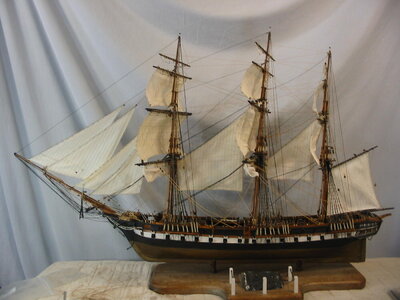
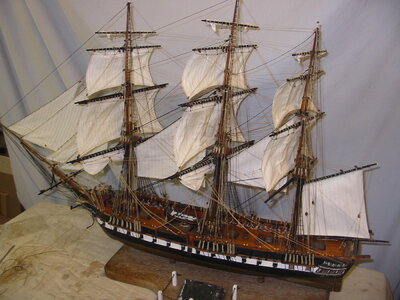
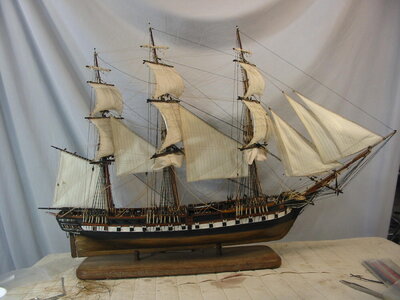
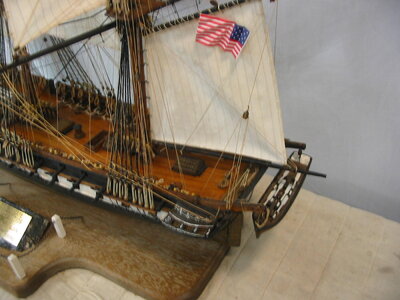
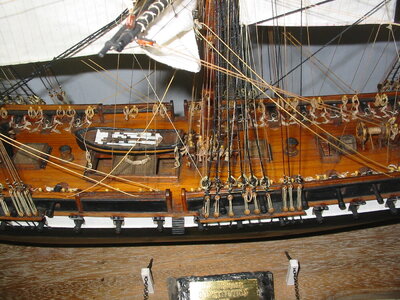
I carefully removed each sail and stored them in clear zip lock bags, backed by a square, larger than the sail, of Bristol board and labeled. These sails were so desiccated by UV as to be virtually no more stable to handle than ash. All the rigging was in the same shape and had to be replaced. I saved all the original hand made blocks and deadeyes to reuse later.
I used photos of the model and MS plans as well as The Anatomy of the Ship Constitution book as a guide to put it back together. I removed all the parts that needed to be repaired and that were coming loose, such as the guns and ships boats. The sails I reproduced by carefully tracing the outline of each onto Bristol board and penciled in all the seamlines. I glued muslin fabric flat and securely to each Bristol board Pattern with Elmer's glue stick which is reversable with water. I put a weighted flat board over each to keep them flat and for good, wrinkle free adhesion. Once dry, I traced all the seam lines onto the fabric with a #3 pencil. I glued wire along all the edges of the sails as "bolt ropes" which could be used to shape the sails later to give the appearance of being filled with wind. I tacked the wire "bolt ropes" in place with dots of CA gel (VERY sparingly as there is a serious antipathy between CA and fabric). to finish securing the wire I ran a discreet bead of white glue along the inside of the wire where it met the fabric and let it dry over night. once thoroughly dry, I very carefully cut away all the scrap board pattern right along the edges of the sail with a pair of scissors right up next to the wire "bolt ropes" I released the sails from the card stock backing pattern daubing them with a damp rag and working a long thin, flexible palette knife between the fabric and the backing until they separated. I had to touch up the gluing of the "bolt ropes" here and there but fortunately,
"it's better to b e lucky than good" About halfway through the project my customer asked if I could rig the guns, which they had not originally been. I said yes and added not enough money to compensate for the added time, which I grossly underestimated.





Last edited:





